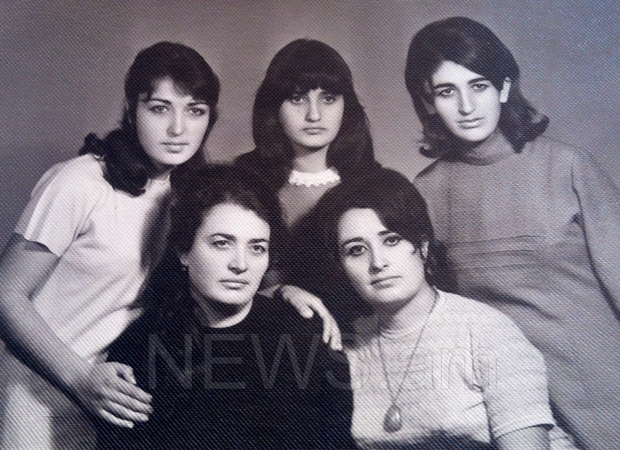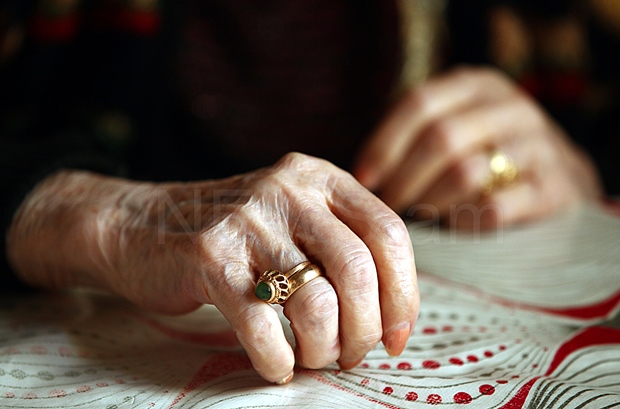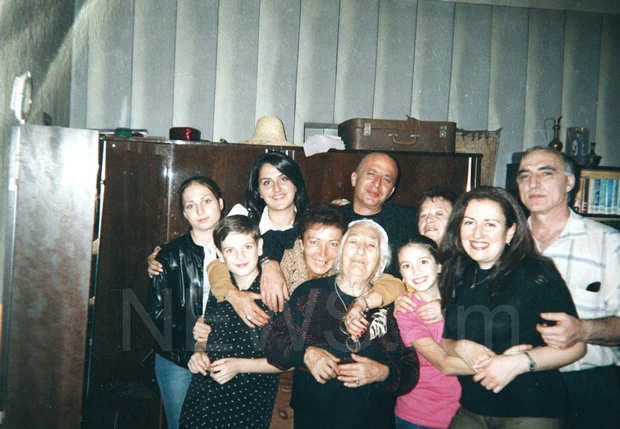
By Ani Afyan
Armenian News-NEWS.am continues publishing stories within "Survivors" project launched ahead of the centennial of the Armenian Genocide perpetrated in the Ottoman Turkey in 1915-23.
“Survivors” is the stories of common people who lost their childhood and homeland.
“Survivors” is a hundred years of memories and pain, hundred years of expecting retribution.
“Survivors” are a diminishing group of people who won't lose their hope for acknowledgement of their pain.
“Survivors” is 100-year-old Margarita Mkhitaryan
White and fragile hands are on the table. Tender hands covered with thin blue veins are indifferent to everything that is going on (PHOTOS).
The table is clean, and only looking at a faded tablecloth one can guess that a lot of people used to gather at this table. Now, next to 100-year-old Margarita Mkhitaryan is her daughter Anahit.
“This house was built by her hands,” Anahit says, adding “they built it with father-in-law in 1950, many years after fleeing from Turkey.”
But, the story of this family starts from the beginning of the twentieth century when a young Armenian woman named Targyul was running away along crowded streets of her native Kars. Her husband and parents were brutally murdered during a clash with Turkish soldiers. The woman with 3-year-old son Adibek in her hands is rushing to her father's house where seven younger brothers are waiting for her in fear and confusion.
“Their house was attacked soon. It was looted and burned to the ground,” Anahit said.
Targyul managed to save her son and younger brother Igit from the burning house. The rest six brothers were burnt alive in front of her eyes.
From that day the picture of red flames, exploding in a blue sky and desperate calls for help will chase her down to the gray hair ...
“Where did she go with her children?”
“Grandma smeared ash on their faces, so that she could say they are girls and ran with them to Aras River.”
On her way to Aras, she heard rumors that the situation calmed down in Kars, and Targyul came back. There she met Nerses Nersisyan. He was a widower and raised three sons - Yeghishe, Avag and Artashes.
Targul and Nerses got married. In 1915 she gave birth to Margarita – a girl who was like a reward for their sufferings. It was time when they heard reports about frequent attacks on Armenians in Turkey. Mass robberies and killings started throughout Turkey. They had to decide something . In 1915 the Nersesyans decided to leave their house and took to the road towards an uncertain future...
In 1918 they stopped in Etchmiadzin and settled in a tent, as many refugees did. Targyul gave birth to their second daughter Seyran.
“Soon grandfather died from a serious illness, and grandmother together with children moved to the village called Tkhit. She was a very strong and hard-working woman.”
No wonder that she was chosen chairwoman of the village council.
In 1930s Margarita got married to Artashes Mkhitaryan. In 1950 they built a house together with her father-in-law Gabriel.
“Grandma passed away in 1952,” Anahit said.
According to her, Targyul died quietly and peacefully. It seemed that she did not die, but just fell asleep, taking with her the pain and bitterness of the past.
After sitting in silence, Margarita Mkhitaryan showed her daughter that she wants to lie down. Anahit brought woolen shawl to cover the skinny shoulders of her mother and helped her to get on the couch.
“She used to dance wll and to sing folk songs. Now it all depends on her mood. But lately, she's really more silent, sometimes she remembers someone from relatives.”
"How many children did Margarita have?"
"There were eight of us.Spartak, Varazdat and Rimma have died..."

“What has happened to their house in Kars? Do you know something about it”
“Kurds lived there. Who knows.. maybe they still live there,” Anahit said with sorrow in her voice.
Mist-covered Mount Ararat is seen from the kitchen window. The mountain is a symbol of homeland for every Armenian in any corner of the world, and the mention of it in this story is not accidental.
In 1986, the Armenian and Turkish newspapers made a fuss because of Hamlet Nersisyan. On August 4, he together with the Barseghyans -- father and son -- traveled to Turkey from Los Angeles and climbed Ararat without permission of Turkish authorities.
“Do you know who he was? Hamlet is a grandson of Yeghishe [son of Nerses],” Anahit said. “He claimed that he would once climb the mountain behind which the home of his grandfather was left. Whatever it may cost him.”
Photo by Arsen Sargsyan/NEWS.am
The previous articles in “Survivors” project are Khosrov Frangyan: 100 years of expecting repentance , Arevaluys Amalyan: 100 years of expecting repentance




